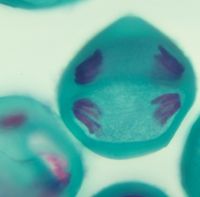My Cart
Your Shopping Cart is currently empty. Use Quick Order or Search to quickly add items to your order!
By Candace Berkeley
Product Developer

Have student groups use sock "chromosomes" and string to model mitosis and meiosis. These 2 simple activities take approximately 30 min to complete. Discussion questions and answers are provided so that you can assess student understanding of each type of cell division.
This activity is appropriate for high school students and addresses the following National Science Education Standards:
Grades 9–12
Life Science
Modeling Mitosis
Modeling Meiosis
Students may struggle with understanding the difference between chromosomes, chromatids, and homologous pairs as they answer the discussion questions. Take a few minutes to discuss the differences between these terms as a class, using models or drawings to help. As with any scientific model, be sure to discuss the model’s limitations so that students do not develop misconceptions. For example, discuss mechanisms that prevent cells from becoming smaller as they divide (e.g., cells expand before division). String lengths and classroom space probably prevent modeling the proportions more accurately. Make sure that students are aware that the pinching of the cell membrane is characteristic of animal cell cytokinesis but that the process differs in plant cells.
As an extension of this activity, have students observe cells in various stages of mitotic and/or meiotic division. Consider using the Fish and Onion Mitosis Slide Set (item #308816) or the Mitosis and Meiosis Slide Set (item #308826).
Modeling Mitosis
Modeling Meiosis
Visit our Mitosis page for more products and resources.